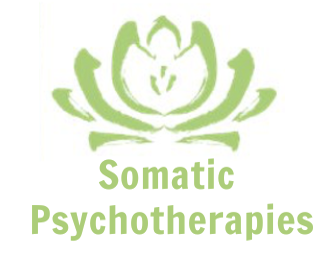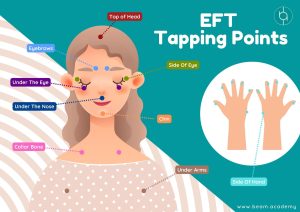What Is EFT Tapping And How Can It Help You?
 EFT Tapping (Emotional Freedom Technique) is a form of therapy that uses a combination of tapping on specific points on your body while focusing on a particular issue, emotion, or memory. It’s based on the idea that our emotions and physical symptoms are connected to energy blockages in the body, and by tapping on certain points, we can release these blockages, becoming ‘unstuck’ bringing balance to both our mind and body. Essentially, it combines exposure, cognitive restructuring and physical relaxation while tapping on a sequence of meridian points and repeating key phrases aloud.
EFT Tapping (Emotional Freedom Technique) is a form of therapy that uses a combination of tapping on specific points on your body while focusing on a particular issue, emotion, or memory. It’s based on the idea that our emotions and physical symptoms are connected to energy blockages in the body, and by tapping on certain points, we can release these blockages, becoming ‘unstuck’ bringing balance to both our mind and body. Essentially, it combines exposure, cognitive restructuring and physical relaxation while tapping on a sequence of meridian points and repeating key phrases aloud.
How EFT Tapping Works:
- Tapping on Acupressure Points: EFT is based on the principles of acupuncture, but without the use of needles. Instead, you use your fingertips to tap on specific points on your body, which are usually located on the hands, head, face, and upper body. These points are part of the body’s meridian system, which is believed to help regulate the flow of energy.
- Focusing on the Issue: While tapping on these points, you’ll focus on a specific problem, negative feeling, or upsetting memory—such as anxiety, fear, phobia, trauma, or even physical pain. You may also say phrases out loud that acknowledge the issue you’re facing (e.g., “Even though I feel anxious about this situation, I deeply and completely accept myself”).
- Releasing Emotional Blockages: The tapping helps release the emotional energy charge tied to the issue. The idea is that when energy is blocked in the body (due to stress, trauma, or unresolved emotions), it can lead to negative feelings or physical symptoms. By tapping, you’re sending signals to the brain and body that help to reduce the emotional intensity, calm the nervous system, and promote a sense of relief.
- Restoring Emotional Balance: As you tap and speak simultaneously, you’re helping your brain and body rewire the emotional response to that issue. In research, EFT Tapping has been shown to reduce stress, anxiety, and emotional pain, and it can also help reduce physical symptoms that are tied to emotional issues (like headaches or tension).
Why It Can Be Effective:
- Calming The Nervous System: Tapping on these points helps activate the body’s relaxation response, calming the parasympathetic nervous system and reducing stress.
- Breaking The Emotional Pattern: EFT works by interrupting the negative emotional or thought patterns that contribute to stress, anxiety, and other emotional struggles. The tapping helps the brain shift its response to these triggers.
- Holistic Approach: Since EFT involves both the mind (thinking about the issue) and the body (tapping on specific points), it creates a holistic approach to healing, addressing both emotional and physical symptoms.
How EFT Tapping Helps The Brain:
 The neuroscience of EFT Tapping is rooted in several key principles of how the brain and body process emotions, stress, and trauma. While the exact mechanisms are still being studied, there is research supporting how tapping can influence brain function, emotional regulation, and the body’s stress response.
The neuroscience of EFT Tapping is rooted in several key principles of how the brain and body process emotions, stress, and trauma. While the exact mechanisms are still being studied, there is research supporting how tapping can influence brain function, emotional regulation, and the body’s stress response.
EFT Tapping (Emotional Freedom Technique) was developed by Gary Craig in the 1990s. Gary Craig, an engineer and personal performance coach, built upon earlier energy psychology techniques, particularly Thought Field Therapy (TFT), developed by Dr. Roger Callahan.
Craig simplified the approach by combining elements of acupressure (tapping on specific meridian points on the body) with cognitive reframing (focusing on specific thoughts or emotions), making it more accessible and easier to use for a broader audience.
Gary Craig introduced EFT as a self-help tool, and over time, it gained popularity as a technique for managing stress, emotional trauma, anxiety, pain, and various other issues. The method has since been widely used by therapists, coaches, and individuals worldwide.
Here’s an overview of how the neuroscience behind EFT works:
1. Regulating The Amygdala (The Brain’s Fear Centre)
The amygdala is a small, almond-shaped structure in the brain that plays a key role in processing emotions, especially fear and stress. In a traumatic or stressful situation, the amygdala becomes highly activated, leading to the body’s “fight-flight-freeze” response. This can cause emotional overreaction or difficulty processing the memory or experience.
- Calming the Amygdala: EFT Tapping has been shown to reduce amygdala activation. When you tap on specific acupressure points, your brain’s nervous system receives signals that help deactivate the stress response in the amygdala. This is why people often experience a calming effect after tapping, even when recalling stressful memories.
- Reduced Emotional Reactivity: By tapping while focusing on a traumatic memory or negative emotion, you can help “neutralise” the emotional charge attached to the memory, making it less triggering over time.
2. Reducing Cortisol (The Stress Hormone)
When the body perceives a threat, it releases cortisol, a hormone that prepares the body for action (e.g., increased heart rate, heightened alertness). Chronic stress or trauma can lead to elevated cortisol levels, which can impair memory, reduce the ability to regulate emotions, and even affect physical health.
- Lowering Cortisol Levels: Research has shown that EFT can lead to a significant reduction in cortisol levels, especially in individuals experiencing high stress or trauma. Studies show that after EFT sessions, cortisol levels drop, leading to a calmer, more balanced state. This is part of the reason why people often feel less anxious and more relaxed after tapping.
3. Balancing The Autonomic Nervous System (ANS)
The autonomic nervous system (ANS) controls automatic body functions like heart rate, digestion, and breathing. It has two main branches:
- The sympathetic nervous system (SNS), which activates the “fight-flight-freeze” response.
- The parasympathetic nervous system (PNS), which calms the body and promotes “rest and digest.”
Trauma and stress often keep the SNS in overdrive, leading to chronic stress symptoms like anxiety, hypervigilance, and difficulty relaxing.
- Activating The Parasympathetic Nervous System: EFT Tapping helps switch the body from the fight-flight-freeze mode (SNS) to a calmer, more relaxed state (PNS). The tapping process, combined with mindful focus on the issue at hand, triggers the parasympathetic response, which helps reduce physiological symptoms of stress (like heart rate, muscle tension, and shallow breathing).
4. Integrating The Prefrontal Cortex (Higher Brain Function)
The prefrontal cortex (PFC) is the part of the brain responsible for higher-level thinking, reasoning, impulse control, and emotional regulation. During stressful or traumatic experiences, the prefrontal cortex can become “overloaded” or less able to regulate the strong emotions triggered by the amygdala.
- Engaging The Prefrontal Cortex: Research has shown that tapping activates the prefrontal cortex, which helps to reframe or reprocess stressful emotions. When you tap while focusing on an emotional issue, you’re engaging the PFC, which helps the brain assess the situation from a more rational, less emotionally-reactive perspective.
- Rewiring Emotional Responses: EFT can help rewire the brain’s response to trauma or stress. By repeatedly tapping on a trigger while engaging the prefrontal cortex, the brain begins to form new associations, reducing emotional intensity and allowing for more balanced emotional regulation.
5. The Role Of The Body’s Energy System
EFT Tapping is based on the principle that the body has an energy system similar to the one in acupuncture, consisting of meridians or energy pathways. These pathways are thought to carry energy throughout the body, and blockages in these pathways are believed to contribute to emotional distress and physical symptoms.
- Restoring Energy Flow: Tapping on specific points along the body’s meridians is thought to clear energy blockages, which may be contributing to emotional or physical distress. The tapping acts as a form of stimulation to these energy points, helping restore a balanced flow of energy and allowing the body to return to a state of calm.
6. Memory Reconsolidation And Emotional Processing
When traumatic memories are formed, they are often stored in the limbic system, particularly in the hippocampus (memory processing) and amygdala (emotion). These memories can become “frozen” or stuck, leading to distressing symptoms such as flashbacks or anxiety.
- Memory Reconsolidation: EFT is understood to facilitate memory reconsolidation, which is the process by which emotional memories are reprocessed and integrated. By tapping while thinking about the trauma, the memory is “reactivated” in the brain, but the calming effect of the tapping helps to soften its emotional intensity. This allows the memory to be stored in a less distressing way, reducing its impact on your current emotional state.
The neuroscience of EFT Tapping suggests that tapping on acupressure points helps regulate key brain areas (like the amygdala) involved in stress and trauma. It calms the autonomic nervous system, lowers cortisol levels, activates the prefrontal cortex for rational thinking, and promotes memory reconsolidation—all of which work together to reduce emotional distress, rewire the brain’s response to stress, and promote healing.
What’s The Difference?
The main difference between talk therapy and EFT Tapping is how they work to help you process emotions and issues.
- Talk Therapy: In talk therapy, you primarily talk about your feelings, thoughts, and experiences. The focus is on understanding and exploring your emotions through conversation with a therapist. The goal is to gain insight, process difficult feelings, and develop coping strategies.
- EFT Tapping: EFT Tapping involves tapping on specific points on your body (like the hands, head, face and body) while focusing on a particular issue or emotion. Instead of conversationally talking about your feelings, the tapping helps release emotional blockages and calm your nervous system, allowing your body and mind to process and let go of stress or negative emotions.
In short, talk therapy is more about verbal exploration and understanding, while EFT Tapping combines physical tapping with mental focus to release emotional stress and promote healing.
EFT Tapping is NOT:
- A Form Of Traditional Talk Therapy: It’s not about discussing deep personal history or emotions in detail like traditional talk therapy. Instead, EFT focuses on reducing emotional intensity by tapping on specific points while thinking about a specific issue.
- A Quick Fix Or Magical Solution: While it can bring relief relatively quickly for many people, it’s not a “magic bullet.” EFT Tapping works to help release emotional blockages, but it may require several sessions to fully address deeper or more complex issues.
- A Substitute For Medical Or Psychiatric Treatment: EFT is not meant to replace professional medical or psychiatric care. While it can help with emotional and psychological issues, it’s not a treatment for serious mental health disorders like psychosis.
- A Mystical Or Unproven Practice: EFT is grounded in principles of neuroscience energy based work and psychology, but it’s not a mystical or pseudoscientific practice. Its effectiveness has been supported by research, but it may not be the sole solution for everyone. Its mechanisms continue to be studied.
- A Physical Treatment Or Massage: EFT involves tapping on acupressure points, but it’s not a form of physical massage or bodywork. Nor does it involve the therapist touching you as the client taps on themselves, while ‘following’ the therapist as they guide the process tapping on themselves simultaneously. The focus is on emotional release, not manipulating muscles or tissues.
- Only For Trauma Or Stress: While EFT is effective for addressing emotional issues like anxiety, stress, and trauma, it can also be used for a range of other concerns, like improving sporting, career or other performances, reducing pain, or even enhancing personal goals.
 More About EFT Tapping & Trauma
More About EFT Tapping & Trauma
Trauma memories can become “stuck” because the brain and body don’t process them fully when the trauma occurs. Here’s why this happens and how EFT Tapping helps to fix it:
Why Trauma Memories Get Stuck:
- Overwhelming Emotions: When we experience a traumatic event, the emotions, physical sensations, and sensory experiences (like sights, sounds, sensations, tastes or smells) are often so intense that they overwhelm the brain’s natural ability to process them. The brain may not be able to properly store or make sense of the memory, so it becomes “trapped” in the body or mind, causing emotional or physical distress.
- Emergency Survival Response: During trauma, the body’s fight-flight-freeze system gets activated to protect you from danger. This can cause the memory to be stored in a heightened emotional state, like fear or panic. When the event is over, the body might not return to a calm, balanced state because the memory hasn’t been fully processed or integrated, keeping the nervous system stuck in a state of alert.
- Energy Blockages: From the perspective of EFT Tapping, trauma creates energy blockages in the body. These blockages happen when unresolved emotional experiences (like fear, sadness, or anger) are trapped in the body’s energy system. These blockages can create ongoing emotional or physical symptoms (like anxiety, tension, or pain).
How EFT Tapping Fixes This:
- Tapping On Acupressure Points: EFT Tapping involves gently tapping on specific points on the body, which are connected to the meridian system (a network of energy pathways in the body). These points are similar to the ones used in acupuncture, and tapping on them helps to activate the body’s natural relaxation response.
- Releasing Emotional Blockages: While tapping, you focus on the traumatic memory or the emotional issue you’re dealing with. By tapping on these acupressure points, EFT helps to “unlock” the stuck emotions or energy, and allow the body to release the intensity. This can reduce the emotional charge tied to the trauma and help you process the memory more effectively.
- Calming The Nervous System: The tapping not only releases emotional blockages but also calms the nervous system. This is particularly important for trauma, because trauma often keeps the body stuck in a heightened state of stress (hypervigilance). EFT helps your body and mind shift from this constant activation of the “fight-flight-freeze” mode back to a regular state of balance and calm.
- Changing The Brain’s Response: By repeatedly tapping while focusing on the trauma, the brain begins to rewire its emotional response to the memory. Instead of the memory causing overwhelming fear, sadness, or panic, EFT helps to neutralise the emotional intensity. This can reduce symptoms like anxiety, intrusive thoughts, flashbacks, hypervigilance and physical tension that result from unresolved trauma.
- Helping Integration: EFT promotes emotional integration by allowing the brain to store the memory in a more balanced way. Instead of the memory being locked in an intense emotional state, it becomes more of a ‘neutral’ event to recall from your past. EFT Tapping can effectively eliminate ‘triggers’ which cause the overwhelming reactions from the past events.
To summarise, trauma memories get stuck because they overwhelm the brain’s processing system, creating energy blockages that keep emotions trapped in the body. EFT Tapping helps release these blockages by tapping on acupressure points while focusing on the traumatic memory. This process calms the nervous system, reduces emotional intensity, and helps the brain and body integrate the trauma, so it no longer feels overwhelming or “stuck.” This leads to emotional healing and a reduction in trauma-related symptoms.
EFT Tapping is a gentle yet powerful tool which can be used in therapy to treat a range of issues including anxiety, trauma, chronic pain, and negative emotions, which ultimately allows you to gain greater control of emotional regulation and positive stress management. Because of its proven effectiveness, it can be a valuable addition to traditional talk therapy or, if you feel you have exhausted that option and want to try EFT Tapping with Somatic Psychotherapies – why not give it a go? It’s simple, safe, and can be done on your own once you’re familiar with the technique which you can then utilise for coping with everyday life stressors as they arise.

“The best things in life are often waiting for you at the exit ramp of your comfort zone.”
– KAREN SALMANSOHN


 More About EFT Tapping & Trauma
More About EFT Tapping & Trauma